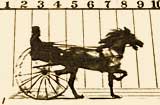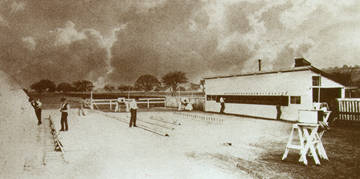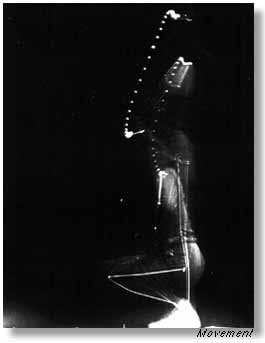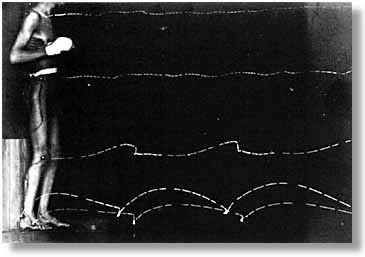Magic
Lanterns
Spinning
Loops
Locomotion
Loops
Chronophotography
Characteristics
Moving Images
Succesive
Photographs
Moving Photographs
Motion/Movement Theme
Loops
Magic Lanterns
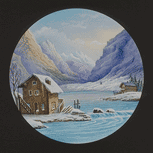  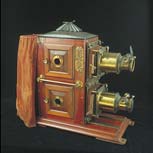
|
Hand-coloured Magic Lantern slides by Newton & Co., 19th
Century
Hand-coloured Magic Lantern slides by Newton & Co., 19th Century These British-made slides show a lake scene during night and day. A 'dissolving pair', they were shown using magic lanterns with two or three lenses. As one lens, projecting one slide, was covered, another lens, showing a second slide registered with the first image, was uncovered to produce a 'dissolve' or transformation between the two projected images.
Hand-coloured Magic Lantern Slipping Slide, 19th Century This British-made slide shows the process of a chrysalis transforming into a butterfly in three stages. Slipping slides consist of one glass slide painted with different stages of a simple movement which is moved across a second, fixed, slide on which the non-changing part of the image is painted. Black patches on the slipping slide alternately cover and uncover the stages of movement.
The Monarch Ethopticon Bi-Unial Magic Lantern, British, 1880s This double-lens magic lantern was made by the Bradford firm of Riley Brothers and projected 3¼" x 3¼" magic lantern slides. It is shown with a mechanical slide in each slide gate. The lamphouse held a limelight illuminant which the operator could adjust through the velvet curtain at the rear.
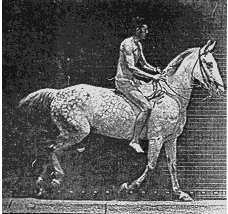 Magic Lantern Show. "The Amazing Ascent of Mount Robson by the Alpine Club of Canada, 1924". A magic lantern show featuring the slides of T.B. Moffat, Calgary Alpinist. http://www.glenbow.ab.ca/lantern/lantern.htm |
Early Cinematography Resource (UK) http://www.nmpft.org.uk/insight/onexhib_cin.asp
http://www.nmpft.org.uk/insight/onexhib_menu.asp
Adventures in Cybersound http://www.acmi.net.au/AIC/phd8150.html
Magic machines http://www.acmi.net.au/AIC/MAGIC_MACHINES_2.html
Spinning Loops
Still images that move - spinning sequences of images
Utilising the Persistance of vision phenomenon, many moving image optical toys and devices were created in the 1800s that created illusions of moving images by presenting sequences of images on devices such as discs and drum that could be spun and/or viewed through mirrors.
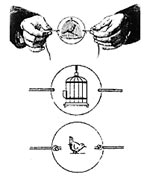 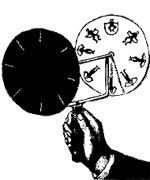 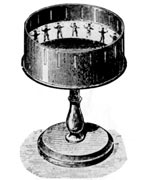 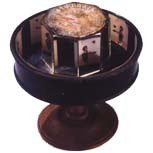 first three from Site EarlyCinema.com, fourth from Link |
Spinning - 'Thaumatrope'
a small disc held by pieces of
string.
Spinning and Mirrors - Phenakistoscope
Spinning and Viewing - Zoetrope
developed by Horner which
eliminated the need for a mirror and allowed several people to view the
device at one time. A drum with an open top into which was placed a hand
drawn sequence of pictures on a strip of paper. The pictures were placed
around the inside of the edge of the drum and could be viewed through
slots in the outside of the drum.
Spinning reflected prisms of
mirrors
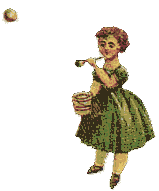 Spinning and Mirrors and Projecting and Viewing -
Praxinoscope
Spinning and Mirrors and Projecting and Viewing -
Praxinoscope
Using a drum design which revolved, as with the
Zoetrope, the images were viewed reflected in a prism of mirrors which
rose from the centre of the drum. Each mirror as it passed flashed a clear
image opposed to it. The result was perfect animation without the loss of
luminosity in movement which was experienced with the Zoetrope. Reynaud’s
Theatre Optique came remarkably close to the cinema - all that it lacked
was the addition of photography.
Praxinoscope animation from link
Build a Zeotrope http://cmp1.ucr.edu/exhibitions/education/vidkids/zoetrope.html
Mutoscope
Locomotion Loops - Eadweard Muybridge - Photography of Capturing Movement
Sequential Recording of Photographs - Sequential Viewing and Playback
San Francisco photographer, Eadweard Muybridge conducted motion-sequence still photographic experiments and is called the "Father of the motion picture" even though he did not make films in the manner we know them as today. Eadweard Muybridge developed a fast camera shutter and used other state-of-the-art techniques of his day to make the first photographs that show sequences of movement. In Muybridge's most famous motion studies, a row of cameras snapped a dozen or more photographs of a passing horse; the public was astonished to see proof that a trotting horse can simultaneously have all four hooves off the ground. For this experiment Muybridge devised a fast camera shutter and used a new, more sensitive photographic process, both of which dramatically reduced exposure time and produced crisp images of moving objects.
He used Several Cameras to Record Successive Photographs of animals and people in motion. He compiled his research into books - one being Animals in Motion (1899)
|
|
1878 Eadweard Muybridge achieves success after five years of trying to capture movement. Muybridge was asked, in 1873, by the ex-governor of California - Leland Stanford to settle a bet as to whether horses hooves left the ground when they galloped. He did this by setting up a bank of twelve cameras with trip-wires connected to their shutters, each camera took a picture when the horse tripped its wire.
"At the time, photographers use the collodion
wet-plate negative that needs from 20 seconds to 5 minutes exposure time.
This is done by removing the lenscap and replacing it. An instantaneous
photograph is defined in the British Journal of Photography Almanack
(1868) as having an exposure under half a second. But even then any rapid
movement will only be photographed as a blur. Muybridge reacts startled at
the boldness of Stanford's request but promises to try...
...body
moving at the rate of thirty-eight feet to the second...
...The space
of time was so small that the spokes of the wheels of the sulky were
caught as if they were not in motion...
...a horse's picture taken
while going thirty-eight feet in a second...
...According to Muybridge
new photographs are made at 1/1000 part of a second. "Link
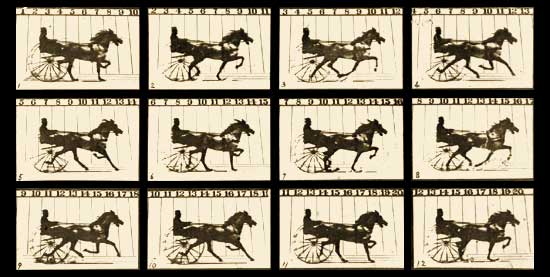 |
Muybridge developed a projector to present his finding. He adapted Horner's Zoetrope to produce his Zoopraxinoscope - first motion-picture.
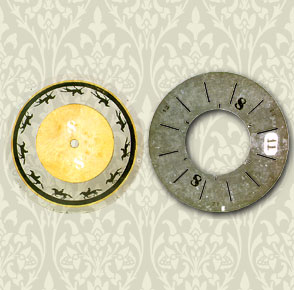 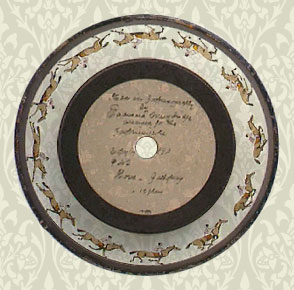 
|
Muybridge secured sets of sequence photographs of
successive phases of the walk, the trot, and the gallop.
   

|
Muybridge's photographs reveal movement only through the sequential ordering of the images, an ordering which was an integral part of Muybridge's presentation of his work.
 In 1879 Muybridge continuous to photograph with 24 cameras
and threads that hang between the shed and the background. By moving
across the track the horse pushes against these threads. Through the push
2 spring-plates come in contact with each other and complete an electrical
circuit that makes an electro-magnet cause a hammer to strike which
releases a catch and both slides of the shutter move simultaneously in
opposite directions. Besides horses also other animals and athletes of the
Olympic Club in San Francisco are photographed. Of each of the series of
images Muybridge makes a single photograph as he has done with "The Horse
in Motion."
In 1879 Muybridge continuous to photograph with 24 cameras
and threads that hang between the shed and the background. By moving
across the track the horse pushes against these threads. Through the push
2 spring-plates come in contact with each other and complete an electrical
circuit that makes an electro-magnet cause a hammer to strike which
releases a catch and both slides of the shutter move simultaneously in
opposite directions. Besides horses also other animals and athletes of the
Olympic Club in San Francisco are photographed. Of each of the series of
images Muybridge makes a single photograph as he has done with "The Horse
in Motion."
Making a Wet Collodion Negative (6:08) Real Video Clip link
Chronophotography - Etienne-Jules Marey 1830-1904
Isolate and Track Movement
Book Animal Mechanism (1874)
Étienne-Jules Marey (b. 5 March 1830; d. 15 May 1904)
started his career as an assistant surgeon in 1855, and specialised in
human and animal physiology. In 1867 he became Professor of Natural
History. He was the inventor of the "chronophotograph" (1888) from which
modern cinematography was developed. Some in fact see Marey, rather than
the Lumière brothers, as the true father of cine photography, though
Marey's equipment had no transparent film, no perforation of film stock,
and no claw to move the film along. Whereas Muybridge had used a number of
cameras to study movement, Marey used only one, and the movements being
recorded on one photographic plate. Characteristic of his pictures were
his studies of the human in motion, where the subjects wore black suits
with metal strips or white lines, as they passed in front of the black
backdrops.
In the early 1880's Marey published pictures of birds in
flight made with his "photographic gun". A forerunner of the motion
picture camera, it had a sight and a clock mechanism and made 12 exposures
of 1/72th of a second each. Marey's observations concerning the changes in
the shape of birds' wings in relation to air resistance was vital in
understanding the phenomenon of flight. Link
Marey was using photography to visualise the up to then unseen nature of movement. Marey was not interested in using photography to represent the exterior motions of his subjects. His photographic method sought to capture the basic principles underlying movement, not simply its representation. Marey also developed several ingenious techniques to further track and isolate movement......One such technique was to cloth his subject completely in black, except for thin white bands which indicated the position of movement of the arms and legs. Photographed against the black interior of one of the "hangers" at the Station Physiologique, the subject's form was reduced to its essential components. These images of soldiers running were part of Marey's research into determining a scientific means of training soldiers.
|
|
|
One of the Chronophotographe cameras invented by the French physiologist Etienne Jules Marey for the purpose of studying movement. It recorded sequential images of a moving subject on a single, static photographic plate. The subjects were photographed against a black background and the sequence of images often overlapped on the photograph. Later, Marey devised a method whereby subjects, dressed in black with while lines along the axes of their limbs, were recorded as a graphic 'trace' on the photographic plate. Link |
His scientific interest is to find the external conditions that influence motions as walking, running and jumping and to measure the energy expended at each instant. Not only of human locomotion but also for horses and of birds in flight. These pages contain only his photographic endeavours from 1882 until his death in 1904 with his cameras as a guideline and animations of his photographs and films. During this time Marey has frequent contacts with Eadweard Muybridge (1881), Albert Londe, and Ottomar Anschütz, and also the Lumières and Edison (1889). http://web.inter.nl.net/users/anima/chronoph/marey/
Chronophotography
is the name
Étienne-Jules Marey (1882) uses to describe the time (chronos) photographs
of movement sequences. For Marey his chronophotographs are a means to
dissect, otherwise invisible stages of movement, for study. This is also
true for the other chronophotographers although not always purely
scientific...
The chronophotographer has to know all the ins and outs
of the photochemical process and the cameras he uses. He has to rely on
his own knowledge or on that of instrument makers for the adaptations to
the camera, the shutter and timing devices. Although Eadweard Muybridge
starts as early as 1872 the technical limitations of the wet collodion
plate and the conventional shutters make it difficult to get good
results. The wet collodion plate needs an exposure time of several
seconds. This process is replaced by the dry plates (1880), the
more sensitive gelatin bromide emulsion on paperfilm
(1888) and finally the celluloid film (1890). More
info (good resource on area)
Marey mapping the body
In 1882, Étienne-Jules Marey successfully employed intermittent movement in a photographic "gun" used to "shoot" birds in flight. Marey achieved a frame rate of 30 images, and employed strips of sensitized paper that used celluloid instead of glass. George Eastman improved upon Marey's work and developed the first convenient celluloid roll film using photographic emulsion. With movie film now available, a practical movie camera was just around the corner Link
LINKS
Chronophotography Links - some video clips available
http://web.inter.nl.net/users/anima/chronoph/index.htm
Video Clips of early work
Etienne Marey Early Films
http://www.nmpft.org.uk/insight/info/fencing.mov
http://www.nmpft.org.uk/insight/info/dropcat.mov
